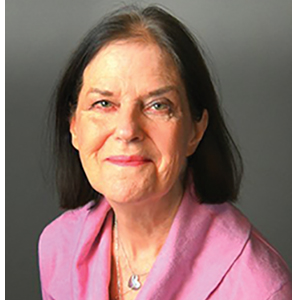Nell Sedransk
Affiliation
Director, National Institute of Statistical Sciences (NISS-DC)
Education
PhD, Statistics, Iowa State University
I grew up as a “faculty brat” in a small town dominated by the life and spirit of the then-college, now university. Statistics was a preeminent department at Iowa State, but George Snedecor, Oscar Kempthorne, H.O. Hartley, and later arrivals H.T. and H.A. David were real people who walked down the street in Campustown Ames and went to the same dinner parties and attended the same concerts as my parents.
Mathematics, music, and languages were at the core of my learning from elementary school through college; statistics came much later. Mathematics was and is my love; music has always been my respite; languages were my ticket to graduate school and a teaching assistantship until a financial scandal rocked the University of Pittsburgh, faculty departed, and the graduate program collapsed.
What to do next?
On a visit home that spring, I was convinced to take an assistantship in statistics. Here was a discipline that relied on the tight logic of mathematics to focus on finding elusive, but real, patterns and relationships.
So, over the course of five decades, what have I done and what have I learned?
As a statistician, I have been fortunate to have been a researcher, collaborator, scientist, teacher, mentor, faculty member, administrator, and institute director. I have worked with brilliant researchers, dedicated physicians, and gifted students and postdoctoral fellows. Over time, my enthusiasm for research in statistics and mathematics broadened with collaboration opportunities first with medicine and then extending to immunology, bioengineering, engineering, IT, social science, ethics, education, and cognition.
How did it start?
The ink was barely dry on my PhD when I joined the department of surgery at the University of Wisconsin and assembled a clinical trials statistical center for cancer research. Spending time at the radiologist’s elbow, I learned the boundaries of a lung tumor are not sharp and distinct, exact repetition of an X-Ray is technically not possible, the best in the world cannot measure without error, and a novice can make a real botch of the measurement. Four lessons in statistics.
Making rounds with the surgeons, I saw the bravery and hope of patients and their families, their faith that something of value would come from joining a clinical trial even as the disease was winning. Good statistical design was no longer an abstract construct. Designing to extract as much information as possible from each patient for sound statistical analysis and useful inferences was a moral issue.
Random assignment was not enough. Statistics really matters. On the National Cancer Institute’s review committee for the cooperative group program (multi-institution clinical trials of cancer therapies), I saw the forefront from the view of leading researchers, clinicians, and cancer center directors. Convincing physicians that stratifying patients according to prognostic factors and disease characteristics to achieve a balanced design was possible and important was perhaps the most significant single accomplishment of my career.
Then what?
A quarter century university career teaching statistics and mathematics, directing graduate research, and pushing the boundaries of “Euclidean space thinking” in theory and practice. For example, the identifiability problems at the Euclidean boundaries for mixture distributions are absent on a connected non-Euclidean space. In the real world, for a quadriplegic patient who governs his arm robotically by voice, what is the shape of space he can reach and control with his “beer grip” and “sandwich grip”? Hint: This space is hollow but can grow both inward and outward with experience or improved robotics.
My term as lead National Science Foundation program director for probability and statistics coincided with the wave to embrace multidisciplinary science, so the three-directorate program (geosciences, geography, math/statistics) was born, especially to bring established statisticians into multidisciplinary research. Simultaneously, a furor among early-career researchers over fairness in journal review led to the idea for a workshop (still continuing) on technical writing in the statistical sciences.
After academia?
Research leadership at two institutes: first the National Institute of Standards and Technology (NIST), then the National Institute of Statistical Sciences (NISS). Five exciting years as director of statistical engineering at NIST, where I was part of a multidisciplinary team overseeing modeling to determine cause and process of the World Trade Center collapse, forensics for matching bullets to tracings, long-range dependency, and atomic clock drift. I was also involved in the introduction of Bayesian inference for metrology at NIST.
Then, research, mentoring, and program building at NISS. I worked with postdoctoral fellows to create new methodology for the analysis of proteomics data, developed a functional data approach to detect changes in cardiac rhythms, and analyzed process data (computer keystrokes) from students’ reading comprehension tests.
As NISS director, I was at a vantage point for connecting diverse experts and building a bridge from important problems to the best of statistical thinking. Who are the statisticians who can bring the expertise (spatial statistics, sample survey theory, Bayesian models, quantitative methodology, GIS, AI, statistical graphics, statistical computation, random trees and forests, time series and extreme values)? What changes are required for demographic data to accurately describe today’s agricultural producers (farmers)? What are the state-of-the-art, the potential for the future, and the limits of possibility for survey nonresponse bias assessment/adjustment? On leveraging additional data resources (national or local scale), how to prioritize? How to draw relevant local inferences? How to visualize statistics and inferences with immediacy?
Where has it arrived?
I always wanted to keep learning and to have the opportunities to do many things. I am truly lucky; my life as a statistician fulfills these hopes.
For me, joy comes in threes: solving intellectual challenges; specific contributions to advances in various disciplines; and students and fellows who have gone on to distinction as statistical scientists, theoreticians and data scientists, and teachers and mentors.


















